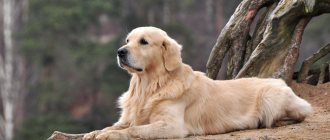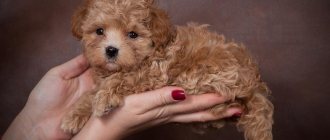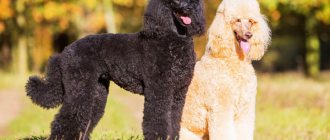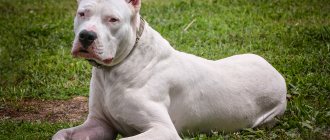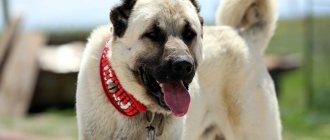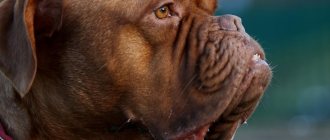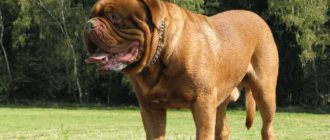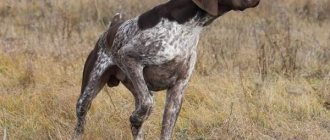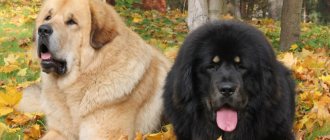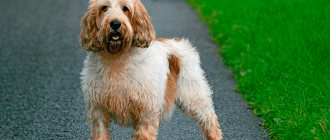Brief characteristics of the dog
- Other possible names: Icelandic Spitz, Icelandic Sheepdog, Icelandic Sheepdog, Farehond Friaar Dog, Icelandic Fairhund.
- Adult height: from 42 cm to 46 cm.
- Weight: from 10 to 15 kg.
- Characteristic color: red and white.
- Coat length: short or long, fluffy.
- Life expectancy: 12-14 years.
- Advantages of the breed: friendly, intelligent, inquisitive, active, hardy.
- Difficulties of the breed: the long-haired species requires care.
- Average price: $300-$500.
History of the breed
Although very little evidence has been preserved about the time of the settlement of Iceland, ancient sagas and legends say that Icelandic sheepdogs came there along with people. They are the only native breed to these harsh islands, to which they have adapted through centuries of isolation.
The hardworking nature of the breed, its devotion and loyalty to its human companions were deeply revered among the people. They valued and revered these dogs so highly that they buried them as people.
Iceland's extreme climate created many problems, and there was a great famine in the 10th century. To survive, people killed and ate dogs, and only the smartest, healthiest and most needed managed to survive.
Since there were no large predators on the islands, or any animals in general, this meant that Icelandic Sheepdogs were not used as hunting dogs, and their character became friendly and strongly people-oriented.
Usually they were used not so much for guarding the herd, but for control and herding. They knew every sheep in their flock, distinguishing them from each other by smell. It is said that the Icelandic watchdog is so successful in this that he can find a sheep buried under several meters of snow.
Excellent cattle dogs, they are still used for this purpose and can handle larger animals such as horses. Cattle breeding received particular development in the Middle Ages and Icelandic dogs were often imported to neighboring countries. Especially in Great Britain, where they became favorite among the nobility and they compiled the first written descriptions of the breed. A merchant and navigator named Martin Behaim mentions them in 1492.
Documents about the breed continue to appear in the following years. Swedish author Olaf Magnus writes in 1555 that these dogs are very popular among Swedes, especially among women and priests. And in 1570, John Claus again names Icelandic dogs as one of the most popular among the British nobility.
Over time, this popularity spread throughout Europe and in 1763 these dogs were known even in Poland. Despite this, by the beginning of the 19th century, Icelandic guard dogs were on the verge of extinction.
The outbreak of an epidemic among sheep spreads to dogs, instantly spreading and destroying the animals. About three-quarters of dogs die as a result of the epidemic.
Due to a significant reduction in the population (including among reference breeders), dogs are beginning to be imported into the country from abroad. The author of a book about Icelandic Spitz, Christian Schierbeck traveled around the country in search of purebred dogs. He managed to find only 20 dogs that matched the original characteristics and those in remote peasant farms.
At that time, purebred Icelandic dogs were so rare that the price of a puppy was equal to the price of a good horse or several sheep. The government banned the import of dogs in 1901 to protect the population.
Gradually, the breed was restored and in 1969 the first club was created - Icelandic Dog Breeder Association (HRFÍ), in 1979 the second - Icelandic Sheepdog Breed Club. Club members are involved in drawing up a breed standard and breeding.
At the moment, about 4 thousand dogs are registered. Despite more than 1,000 years of history, the breed was not recognized by the AKC until July 2010.
Appearance
In appearance, shepherd dogs from Iceland resemble Welsh Corgs - the favorites of the Queen of England and the smallest shepherd dogs in the British Isles. Dogs have approximately the same body weight - 10-15 kg, but Icelanders have longer legs and therefore their height at the withers can reach 48 cm, and not 30 cm, like Corgis. In height, Icelanders are close to Malinois shepherd dogs - herding dogs from Belgium.
The Icelandic dog has a fox-like muzzle. Dogs have protruding, straight, triangular ears, wide at the base, lips that fit tightly to the muzzle. A dog's nose can be black or dark brown. The bite of the teeth is scissor-shaped. The eyes are small, round, dark.
Shepherd dogs from Iceland have a strong neck, a short strong proportional body, muscular withers and limbs, a strong back, an elastic lower back, a wide chest and croup, a well-tight stomach, and oval-shaped paws.
The dogs' tail is set quite high; they hold it curled into a ring above their back. The body and tail of dogs are covered with thick hair. According to the quality of the surface coat, shepherd dogs can be short-haired, with a slightly coarse coat of medium length and a soft, dense undercoat, or long-haired, with a very coarse coat and a soft undercoat. The length of the hair on the face, ears, and front legs is shorter than on the neck, behind the ears, on the chest, hips, and hind legs.
Description
They belong to one of the most ancient groups - Spitz dogs and are close in appearance to wolves. These are medium-sized dogs, males at the withers reach 46 cm, females 42 cm, weight 12-15 kg. Males are built more solidly and muscular, while females are graceful and elegant.
Icelandic Sheepdogs can have either short or long coats, but always have double coats and thick, waterproof coats.
The coat consists of a coarse outer coat and a soft but dense undercoat that helps keep the dog warm. Both long-haired and short-haired are shorter on the face, ears and front of the paws, longer on the neck and chest. The tail is fluffy, with long feathering.
They are distinguished by a variety of colors, where one main one can be supplemented with spots of different colors. Typically, dogs are black, gray, brown, and the latter can vary from cream to reddish.
Typically, all dogs have white markings on their face, chest, or paws. Light-colored dogs have a black mask on their face.
Trimming is prohibited for dogs participating in exhibitions, as the animal must look as natural as possible.
Purpose of the breed
Icelandic dogs are almost never used for their original purpose, that is, they can rarely be seen hunting. But in some areas of Iceland they still occasionally herd livestock.
A good sense of smell allows, in some cases, to use Irish Shepherds to search not only for animals, but also for people. Most often, they serve as simple pets, and sometimes as vigilant watchmen. They are also regulars at exhibitions and participants in various competitions.
Best nicknames
Abroad, male Icelandic Shepherd puppies are called Basti, Kniff, Vinsett, Dayron, Vesamont, Brusik, Lauren, Alfred. For girls, the nicknames Zukhra, Malibu, Melena, Gafa, Ailanta, Zhunya, Indy were invented.
Dogs of any breed that are liked by their owners will always be the most beloved, despite all their shortcomings. But dogs of the Icelandic dog breed have practically no disadvantages, except for two - they cannot be bought in Russia and they bark very loudly and loudly.
But the dogs have a unique character. They are friendly, sociable, easy to train, love people, and with proper upbringing they completely obey their owner. Probably many would like to have such dogs.
*Prices are current as of December 2022.
Character and behavior
Judging by the description of Icelandic Sheepdog breed experts, these dogs are not capricious in everything. They perceive life as a holiday. They always have joy and friendliness shining in their eyes. Modern dogs have inherited from their ancestors the ability to protect. Once upon a time, shepherd dogs searched for lambs lost in the snow and protected them from attacks by birds of prey. Now they also have the habit of being vigilant and observing what is happening around them. Dogs will always rush to protect their owner, his children, a puppy or a kitten in a moment of danger.
Without training or training, they will be able to open the door of a bedside table or cabinet just to find out what is inside. During a walk, the pet will never go far from the owner, always watches him and comes running at the first call.
Dogs cannot stand being alone; from puppyhood they must be taught that people can go somewhere. Otherwise, the pet will perceive parting with people very painfully. A dog living in an apartment must be provided with toys during absences, otherwise the neighbors will begin to complain about his incessant whining and barking, and the Icelanders have a ringing and loud voice. The best place to keep it is a country house with an outdoor enclosure, a booth and plenty of space for walking.
Mating
Breeding the Dutch Herder must be done carefully, always avoiding accidental mating. It is necessary to choose a partner carefully, even within a breed, since short-haired, long-haired and wire-haired varieties should not be crossed with each other.
Mating of a Danish Shepherd can be carried out when the dog has reached the age of 2 years. Mating always takes place in the male dog's territory. The pedigree qualities of the male must be equal to or exceed the class of the female.
In order to guarantee pregnancy, mating is carried out again after a day.
Pregnancy
The gestation period for Shepherds varies from 50 to 56 days. During this time, the animal should be provided with high-quality and balanced nutrition, and serious physical and psychological stress should be avoided. The litter of this breed is small - 4-6 puppies; the first time a female produces fewer offspring. It is advisable to carry out childbirth only under the supervision of a veterinarian in order to avoid unpleasant consequences and carry out the necessary resuscitation measures in a timely manner.
The Dutch Shepherd has good maternal instincts. After giving birth, the bitch's guarding skills may become more acute. To prevent such changes, ensure that your pet is kept in a comfortable and quiet environment during this period.
Estrus
In the Dutch Shepherd, the first heat occurs between the ages of 6 and 11 months. Normally, it lasts from 20 to 23 days, and then repeats with regularity up to 2 times a year. The dog's behavior and habitual way of life changes. The bitch becomes more lethargic or active, and her appetite changes. The main sign of the onset of estrus is increased urination and an increase in the size of the labia. During this period, all walks should only be on a short leash. It is advisable to wear special underpants indoors to make caring for your pet and cleaning up during discharge easier.
Education and training
Dogs from Iceland have a lively mind, are observant, flexible, and are easy to accustom to everyday life. Puppies quickly socialize and learn hygiene. Dogs can be both beloved companions and household helpers. They quickly remember commands and carry them out with joy. For them, learning is more of a game than a responsibility.
Note! The physical characteristics of Icelandic Shepherds allow them to participate in freestyle and agility competitions.
Icelandic dog: conditions of detention
Oddly enough, although the dog is small, it is not suitable for living in a city, in an apartment. Firstly, this is a very active dog that requires a lot of space so that it can get the physical activity it needs. Twice-a-day parties are not enough here. Secondly, this breed requires not only physical, but also intellectual stress. This is problematic in an apartment; she quickly gets bored. Thirdly, don’t forget that this dog loves to “talk” - your neighbors definitely won’t like it.
Care
These are fairly unpretentious animals to care for. The maximum that is required of you is infrequent washing as needed, brushing once a week (more often during the shedding period) and minimal ear care. You should also keep an eye on the claws. And don't forget about regular flea and tick treatments. But most of these recommendations are relevant for all breeds, so we can say that the Icelandic dog does not need any special care - after all, it is a Viking dog!
Hygiene
Grooming involves periodic brushing. Regularity of the procedure will reduce the likelihood of matted fur and remove accumulated dirt. It is enough to brush your Icelander once a week. But during the molting period (spring and autumn), the procedure must be carried out more often. Grooming of this breed is not practiced.
Nails are trimmed as they grow. Do not neglect the procedure, because there are often cases of claws growing into the fingertip.
Washing your dog frequently is not recommended. Frequent bathing leads to the fact that the natural protective fatty film on the animal’s skin is washed away. As a result, the skin becomes dry and irritated, and the dog’s resistance to frost decreases.
It is necessary to clean the ears 3-4 times a month. The eyes are rubbed as discharge appears on them.
To prevent the appearance of fleas and ticks, it is necessary to use special collars or repellents (insect repellents).
Hygienically, caring for an Icelandic dog is kept to a minimum: regular brushing, ear cleaning and nail trimming.
Walking and exercise
Icelandic dogs cannot live without movement, they have a lot of energy and if they do not splash it out, they will begin to become decrepit early, although the average life expectancy of these dogs is 14 years. Therefore, daily 2-hour walks are mandatory.
There are practically no genetic diseases in this breed. Sometimes cases of hip dysplasia are detected, but treatment of the disease with timely consultation with a veterinarian occurs without complications. Older Icelandic Shepherds are prone to eye problems. Dogs are vaccinated according to a schedule agreed with veterinarians. Vaccinations against rabies (at 6 months), against plague, parovirus (at 6-9 weeks), a second vaccination against rabies and leptospirosis (at 12 months) are required.
Nutrition
In general, it is noted that animals belonging to the Icelandic breed are not demanding in relation to their diet. However, even despite this, you cannot neglect planning your four-legged friend’s meals and feed him scraps from the master’s table. It should be remembered that one way or another, the animal’s nutrition should be healthy and balanced. Try to saturate it with the maximum possible amount of useful components that will ensure the active growth and development of the animal.
As the basis for your pet's nutrition, you can choose ready-made dry mixtures and food that are sold in pet stores and zoological markets. This option may seem more convenient and comfortable for those who do not like to cook and want to make the task of providing food for their pet as easy as possible.
However, if you choose this option, then before buying this or that food, you should consult with a specialist in advance and find out whether it is suitable specifically for your pet . In addition, in this case you will need to purchase various nutritional supplements and vitamins necessary for the animal’s body.
The second option is considered more budget-friendly, but it is time-consuming. So, you can feed your Icelandic Shepherd with natural products that you eat yourself. The dog's diet should consist of cereals, vegetables, fruits, dairy products, as well as lean meat and fish. Remember that when choosing natural food, you must prepare food for your dog separately. They must be fresh and of high quality. Under no circumstances should you give your pet expired, spoiled or stale food. You should also avoid feeding him scraps from your table.
Estrus in South Russian Shepherds
- age of onset of the first estrus in a female dog is 12-14 months;
- duration of estrus is 20-22 days, sometimes up to a month;
- frequency of estrus – 1-2 times a year with an interval of 6-9 months;
- signs of estrus – swelling of the dog’s external genitalia, spotting;
- frequent urination - having to walk more often than usual;
- psychological signs - a change in the dog’s behavior - from aggressive to lethargic;
- perhaps there is a change in appetite and the dog drinks more water;
- often bitches begin to shed before going into heat;
- lick the loop intensively.
You can notice the approach of estrus while walking your dog. Behavior can change, often the dog becomes active, playful and disobedient, or, on the contrary, looks unhappy and lethargic. The bitch makes frequent marks - scent “lures” for male dogs, and urination occurs more frequently. The loop becomes more and more swollen; when pressed, you can see a discharge of light pink or dull pink color. If you notice changes in the dog's behavior, do not be lazy and check the dog every day for the onset of heat by dabbing the bitch's loop with a napkin or toilet paper. Pinkish discharge will be the beginning of estrus - mark this day in your dog’s notebook.
The course of the dog's first heat.
- The first heat in dogs is not the same as the next one.
- It may be shorter or longer than the usual estrus period.
- The bitch has either only weak manifestations of estrus, or, conversely, very heavy discharge.
- The first heat may suddenly stop, and then after some time begin again.
- There may be mucous discharge from the loop, a smell that attracts males, and the estrus itself will begin after some time.
- Try not to miss the start time of the first, and subsequently the second estrus, in order to correctly determine the intervals between estrus and know their timing and duration.
Precautions during estrus. If you are not interested in getting puppies from a dog, you need to take precautions during heat:
- walk your dog ONLY on a leash: even the most obedient dog these days can simply run away, not paying attention to commands;
- do not allow male dogs to mount the dog: if sexual intercourse begins, it is almost impossible to separate them;
- during a walk, literally DO NOT take your eyes off the dog, even when buying bread in a tent, eliminate or minimize contact with male dogs;
- there is a danger of the dog catching a cold in the cold season, the best way to protect yourself is not to walk for a very long time in cold weather and use dog clothes;
- If your dog lives freely on your territory, then from the moment the estrus begins, lock the dog in an enclosure.
Pregnancy and childbirth
Pregnancy in dogs lasts 56–72 days. The number of puppies in the litter depends on the age of the female. The maximum number of puppies is born in dogs 3–4 years of age. During pregnancy, it is necessary to pay special attention to the nutrition of the expectant mother.
During childbirth, the female becomes anxious. Due to the strong emotional connection between the dog and the owner, his excitement is transferred to her. Therefore, the pet owner needs to prepare for the birth and be calm so that the pet does not experience even more severe anxiety.
Feeding
These animals are ready to eat whatever their owner prepares for them. It is important not to give too much food and follow a certain feeding schedule. For an adult, two meals a day is enough. Food should not contain a lot of fat, be balanced, rich in minerals and vitamins.
Veterinarians advise feeding the animal after a walk. The diet should contain by-products, fruits, cereals, meat, vegetables, dairy products and boneless sea fish. After eating, the animal must rest for some time, otherwise intestinal volvulus may occur.
Tendency to diseases
Like most hunting and herding dogs, Icelandic dogs have very good health. This is due to the natural selection that they went through during the entire period of their existence. The strongest, hardiest animals with good immunity survived in harsh conditions. They practically independently obtained their own food and found shelter from bad weather.
Representatives of this breed are prone to hip and elbow dysplasia and luxation of the patella. Both ailments, as a rule, do not cause much trouble for the dog and are sometimes discovered during a regular examination by a veterinarian.
The “Dog Doctor” and your pet are visited at least once a year. The veterinarian examines the animal and vaccinates it. The Icelandic woman tolerates examinations and procedures calmly, especially if the owner is nearby.
On average, these dogs live 12–14 years, remaining active and good-natured until old age. With proper care, proper nutrition and sufficient (but not excessive) physical activity, they can live 2-3 years longer.
Table: vaccination schedule for the Icelandic dog
| Age | Vaccination |
| 6 weeks | Plague, parvovirus |
| 8–9 weeks | Plague, parvovirus, hepatitis, parainfluenza, adenovirus |
| 12 weeks | Revaccination |
| 6 months | Rabies |
| 1 year | Rabies, leptospirosis |
| 3 years | Revaccination against all diseases, including leptospirosis and parainfluenza, is carried out every year |
Icelandic dogs are wonderful four-legged friends with a long history as a breed. Cheerfulness, boundless love for the owner, devotion and kindness make dogs of this breed ideal pets. The Icelandic Shepherd Husky is suitable for an active person who is ready for long walks in the fresh air.
Health
The Icelandic Sheepdog has good health, tempered by the harsh climate of its homeland.
Life in harsh climatic conditions and natural selection did their job, providing the Icelandic watchmen with excellent health and a strong immune system. No dangerous hereditary predispositions were found in them. A Spitz from Iceland can live for about 12–14 years.
Icelandic Shepherds need to be vaccinated regularly (once a year) and dewormed (once every six months). Measures to protect against ticks and fleas (collars, drops, etc.) are necessary.
Advantages and disadvantages
Icelandic Shepherds are excellent family dogs with virtually no faults . They are incredibly loyal and so attached to a person that they always try to be as close to him as possible. True, sometimes they can get in the way and get under your feet.
The desire to please and high intellectual abilities allow the Icelandic dog to learn quickly and remember everything well . And activity and mobility often make her a champion in various types of dog sports.
But such an energetic dog requires long daily walks. Therefore, it is not suitable for sedentary people , or as a sofa pet.
These are very cheerful and cheerful dogs who love to frolic and play . Often other pets also participate in these games, on which, even during entertainment, the Icelandic Shepherd shows its herding instinct, not allowing them to leave the territory and trying to keep everyone in one place. The same applies to children, with whom such a pet has a wonderful relationship.
The Icelandic Sheepdog does not forget about protecting its territory. She will always notify the arrival of guests, and in some cases she will be able to bravely protect the owners from uninvited strangers . Although the dog treats strangers with some distrust, when he sees the joy on the owner’s face, he immediately becomes peaceful and affectionate.
These dogs are very dependent on human communication and have difficulty withstanding loneliness . And some breeders even recommend trying to give such a pet as much attention as possible until the age of eighteen months, gradually teaching it to be left alone.
Icelandic Shepherds are affectionate and loving . They know how not only to receive, but are also ready to give all their tenderness in return and become a faithful companion for their human family.
Nutrition
The main rule of feeding a Swiss Shepherd, in principle, like other pets, is regularity, balance and completeness. For an adult dog, one meal in the morning and one in the evening will be enough.
Puppies should receive food at least four times a day, and from six months - three times. If the animal lives in the house, it is better to place the bowl not in the kitchen, but next to it - this is part of the upbringing from the point of view of the family hierarchy in the eyes of the pet.
The serving size should be designed for one meal so that the dog does not overeat. And in the cold months of the year, if the animal lives in a private sector, you need to slightly increase the portion.
For BShO, it is allowed to feed only premium dry food or use a mixed type. Although it will be more difficult to properly structure a diet of natural food, it is more beneficial for a Swiss Shepherd.
When choosing ready-made food, you need to select the manufacturer and type of product individually for each dog. If this is not done or a low-quality product is given, many health problems can arise: from allergies and urolithiasis to tumors.
Every day an adult should receive about 0.5 kg of meat. It is best to choose lean meats, such as chicken and other poultry, rabbit or beef. You should not feed your animal bones as it may choke. Fish should also be present in the diet (both river and sea species are suitable), but in this case the owner must be especially attentive to the absence of bones.
The shepherd dog eats many types of porridge (buckwheat, rice, millet, etc.) as a side dish with pleasure. They need to be boiled in unsalted water with the addition of one tablespoon of high-quality oil. Bone meal and fish oil are also welcome in the diet.
However, the diet will not be completely balanced if you do not add eggs (three pieces a couple of times a week), fermented milk products (milk, kefir, yogurt and cottage cheese). BShOs are also very fond of various vegetables and even some fruits (for example, apricots, raspberries).
White Swiss Shepherd is a very beautiful dog
There should always be water in the dog’s bowl; it should be changed at least every other day. In addition, adding vitamins, minerals, special complementary foods and treats to the diet will also not be superfluous. They should be chosen according to the age of the pet and the advice of the veterinarian.
Choosing a puppy and its cost
Buying a small Icelander is not easy, since there are literally only a few of them in our country. For a puppy, it is better to contact specialized nurseries located in Denmark, Sweden, in their homeland of Iceland or in the USA. A conscientious breeder will definitely provide the necessary set of documents (parental pedigrees, puppy statistics, etc.) proving the fact of the pet’s thoroughbred.
The cost of a puppy can vary from 30 to 35 thousand rubles, depending on the status of the nursery and the prospects of the baby himself.
It is not recommended to buy dogs offered through advertisements or by hand, since purebred Icelandic Shepherds are often passed off as different crossbreeds with huskies. Only an experienced dog handler can distinguish them visually.
Sources
- https://www.moiasobaka.com/vse-o-porodah/srednie/islandskaya-sobaka.html
- https://catfishes.ru/islandskaya-sobaka/
- https://gafki.ru/sobaki/islandskaya.html
- https://prohvost.club/sobaki/porody-sobak/islandskaya-ovcharka-foto.html
- https://alldogs.info/%D0%B8%D1%81%D0%BB%D0%B0%D0%BD%D0%B4%D1%81%D0%BA%D0%B0%D1%8F-% D1%81%D0%BE%D0%B1%D0%B0%D0%BA%D0%B0/
- https://kot-pes.com/islandskaya-sobaka-foto/
- https://vplate.ru/sobaki/islandskaya/
- https://DogGav.ru/porody/srednie/islandskaya-sobaka.html
[collapse]
